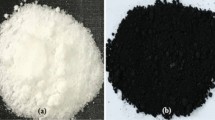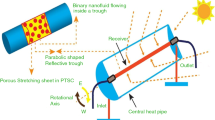Abstract
The main objective of this study is to investigate three distinct non-commonly used metal oxide-based nanoparticles, i.e., CuO + MWCNT, MgO + MWCNT, and SnO2 + MWCNT with a weight mixture ratio of 80:20 each (by weight ratio) and DI water as a base fluid along with the addition of the CTAB surfactant at 3:2. The study incorporates the effect of varying size, dp (20–50 nm), different temperature range (25–50 °C), and volume concentration range of 0.25–1.5%. After examining the stability of prepared HNF over the 30th day from the preparation day and some of the meticulous experimentation on isobaric heat capacity, a new correlation is developed to predict the specific heat of hybrid nanofluid. Considering various parameters like various volume concentration (φ = 0.25–1.50%) and temperature range (T = 25–50 ℃), specific heat of nanofluid, specific heat of base fluid, density of nanofluid, density of base fluid, and average diameter of used nanoparticles. The developed correlation was with 2.93% and 0.903% maximum and average absolute deviation, respectively. Experimental results show the maximum decrement in specific heat value is about 15.09% compared to base fluid DI water at 25 ℃ and 1.50% volume concentration with an average particle diameter of 20 nm for the MgO + MWCNT (80:20)/water HNF. However, it is found that the rate of decrement decreases with the increase of dp from 20 to 50 nm. From the current experimental results, it is concluded that the usage of HNF on relatively higher temperature significantly influences the overall thermophysical properties such as enhancement in thermal conductivity and decrement in viscosity of the working fluid, by paying the marginal loss in specific heat capacity. Therefore, it recommended that the usage of HNF on higher temperature is more beneficial for critical heat transfer application such as HVAC, effective thermal management of the system, natural and forced convection phenomenon.









Similar content being viewed by others
Abbreviations
- CNT:
-
Carbon nanotube
- SWCNT:
-
Single-wall carbon nanotube
- MWCNT:
-
Multiwall carbon nanotube
- DI:
-
Deionized
- EG:
-
Ethylene glycol
- HNF:
-
Hybrid nanofluid
- SS:
-
Stainless steel
- LDH:
-
Layered double hydroxide
- PHE:
-
Plate heat exchanger
- rGO:
-
Graphene oxide
- GnPs:
-
Graphene nanoplatelets
- IL:
-
Ionic liquid
- OA:
-
Oleic acid
- SDBS:
-
Sodium dodecyl benzene sulfonate
- SDS:
-
Sodium dodecyl sulphate
- CTAB:
-
Cetyltrimethylammonium bromide
- DDC:
-
Distearyl dimethylammonium chloride
- GA:
-
Gum arabic
- PVP:
-
Polyvinyl pyrrolidone
- ST:
-
Surfactant type
- SMR:
-
Surfactant mixing ratio
- PD:
-
Preparation day
- k:
-
Thermal conductivity, W/m.K
- T:
-
Temperature, ℃
- T0 :
-
Reference temperature, ℃
- V:
-
Volume
- ∆V:
-
Additional volume
- Cp:
-
Specific heat (kJ/kg.K)
- φ:
-
Nanoparticle volumetric concentration (%)
- ω:
-
Weight concentration (%)
- ρ:
-
Density, kg/m3
- r:
-
Ratio
- bf:
-
Base fluid
- nf:
-
Nanofluid
- eff:
-
Effective
References
Ahmad S, Nadeem S, Ullah N (2020) Entropy generation and temperature-dependent viscosity in the study of SWCNT–MWCNT hybrid nanofluid. Appl Nanosci. https://doi.org/10.1007/s13204-020-01306-0
Alade IO, Abd Rahman MA, Saleh TA (2019) Predicting the specific heat capacity of alumina/ethylene glycol nanofluids using support vector regression model optimized with Bayesian algorithm. Sol Energy 183:74–82. https://doi.org/10.1016/j.solener.2019.02.060
Babita SSK, Gupta SM (2016) Preparation and evaluation of stable nanofluids for heat transfer application: a review. Exp Therm Fluid Sci 79:202–212. https://doi.org/10.1016/j.expthermflusci.2016.06.029
Bock Choon Pak YIC (2013) Hydrodynamic and heat transfer study of dispersed fluids with submicron metallic oxide. Exp Heat Transf A J Therm Energy Transp 11(2):151–170
Choi SS, Eastman AA (1995) Enhancing thermal conductiivity of fluids with nanoparticles. In: International mechanical engineering congress and exhibition, San Francisco, CA (United States), 12–17 Nov 1995, ASME Puplications FED
Das PK (2017) A review based on the effect and mechanism of thermal conductivity of normal nanofluids and hybrid nanofluids. J. Mol, Liq
Ghodbane M, Said Z, Hachicha AA, Boumeddane B (2020) Performance assessment of linear Fresnel solar reflector using MWCNTs/DW nanofluids. Renew Energy. https://doi.org/10.1016/j.renene.2019.10.137
Gupta M, Singh V, Said Z (2020) Heat transfer analysis using zinc Ferrite/water (Hybrid) nanofluids in a circular tube: an experimental investigation and development of new correlations for thermophysical and heat transfer properties. Sustain Energy Technol Assessments. https://doi.org/10.1016/j.seta.2020.100720
Hachicha AA, Said Z, Rahman SMA, Al-Sarairah E (2020) On the thermal and thermodynamic analysis of parabolic trough collector technology using industrial-grade MWCNT based nanofluid. Renew Energy. https://doi.org/10.1016/j.renene.2020.07.096
Hajizadeh MR, Abohamzeh E, Tiwari AK et al (2020) Discharging of PCM for ventilation system incorporating nanoparticles. J Mol Liq. https://doi.org/10.1016/j.molliq.2020.113696
Irfan M, Rafiq K, Khan WA, Khan M (2020) Numerical analysis of unsteady Carreau nanofluid flow with variable conductivity. Appl Nanosci. https://doi.org/10.1007/s13204-020-01331-z
Jo B, Banerjee D (2014) Enhanced specific heat capacity of molten salt-based nanomaterials: effects of nanoparticle dispersion and solvent material. Acta Mater 75:80–91. https://doi.org/10.1016/j.actamat.2014.05.005
Karimi H, Yousefi F (2012) Application of artificial neural network-genetic algorithm (ANN-GA) to correlation of density in nanofluids. Fluid Phase Equilib. https://doi.org/10.1016/j.fluid.2012.08.019
Khan WA, Ali M, Irfan M et al (2019) A rheological analysis of nanofluid subjected to melting heat transport characteristics. Appl Nanosci. https://doi.org/10.1007/s13204-019-01067-5
Kumar Sharma A, Kumar Tiwari A, Rai Dixit A, Kumar Singh R (2020) Measurement of machining forces and surface roughness in turning of AISI 304 steel using alumina-MWCNT hybrid nanoparticles enriched cutting fluid. Meas J Int Meas Confed. https://doi.org/10.1016/j.measurement.2019.107078
Kumar V, Pandya N, Pandya B, Joshi A (2019) Synthesis of metal-based nanofluids and their thermo-hydraulic performance in compact heat exchanger with multi-louvered fins working under laminar conditions. J Therm Anal Calorim 135:2221–2235. https://doi.org/10.1007/s10973-018-7304-x
Kumar V, Tiwari AK, Ghosh SK (2018) Exergy analysis of hybrid nanofluids with optimum concentration in a plate heat exchanger. Mater Res Express. https://doi.org/10.1088/2053-1591/aac799
Moldoveanu GM, Minea AA (2019) Specific heat experimental tests of simple and hybrid oxide-water nanofluids: proposing new correlation. J Mol Liq 279:299–305. https://doi.org/10.1016/j.molliq.2019.01.137
Murshed SMS (2011) Determination of effective specific heat of nanofluids. J Exp Nanosci 6:539–546. https://doi.org/10.1080/17458080.2010.498838
Pandya NS, Shah H, Molana M, Tiwari AK (2020) Heat transfer enhancement with nanofluids in plate heat exchangers: a comprehensive review. Eur J Mech B/Fluids 81:173–190. https://doi.org/10.1016/j.euromechflu.2020.02.004
Qiu L, Zhu N, Feng Y et al (2020) A review of recent advances in thermophysical properties at the nanoscale: from solid state to colloids. Phys Rep 843:1–81. https://doi.org/10.1016/j.physrep.2019.12.001
Satti JR, Das DK, Ray D (2016) Specific heat measurements of five different propylene glycol based nanofluids and development of a new correlation. Int J Heat Mass Transf 94:343–353. https://doi.org/10.1016/j.ijheatmasstransfer.2015.11.065
Sekhar YR, Sharma KV, Sciences B, Nadu T (2013) Study of viscosity and specific heat capacity characteristics of water- based Al2O3 nanofluids at low particle concentrations. J Exp 10(2):37–41. https://doi.org/10.1080/17458080.2013.796595
Sharma AK, Singh RK, Dixit AR, et al (2019) An investigation on tool flank wear using alumina/MoS2 hybrid nanofluid in turning operation. In: Lecture Notes in Mechanical Engineering
Sheikholeslami M, Jafaryar M, Shafee A, Babazadeh H (2020) Acceleration of discharge process of clean energy storage unit with insertion of porous foam considering nanoparticle enhanced paraffin. J Clean Prod 261:121206. https://doi.org/10.1016/j.jclepro.2020.121206
Shin D, Banerjee D (2011) Enhancement of specific heat capacity of high-temperature silica-nanofluids synthesized in alkali chloride salt eutectics for solar thermal-energy storage applications. Int J Heat Mass Transf 54:1064–1070. https://doi.org/10.1016/j.ijheatmasstransfer.2010.11.017
Syam Sundar L, Said Z, Saleh B et al (2020) Combination of Co3O4 deposited rGO hybrid nanofluids and longitudinal strip inserts: thermal properties, heat transfer, friction factor, and thermal performance evaluations. Therm Sci Eng Prog. https://doi.org/10.1016/j.tsep.2020.100695
Vajjha RS, Das DK (2008) Measurements of specific heat and density of Al2O3 nanofluid. AIP Conf Proc 1063:361–370. https://doi.org/10.1063/1.3027181
Verma SK, Tiwari AK, Tripathi M (2018) An evaluative observation on impact of optical properties of nanofluids in performance of photo-thermal concentrating systems. Sol. Energy 176:709–724
Zhelezny VP, Motovoy I V., Ustyuzhanin EE (2017) Prediction of nanofluids properties: The density and the heat capacity. In: Journal of Physics: Conference Series
Zhong Q, Dong X, Zhao Y et al (2019) Thermodynamic properties of (R1234yf + R290): isochoric pρTx and specific heat capacity c v measurements and an equation of state. J Chem Thermodyn 129:36–43. https://doi.org/10.1016/j.jct.2018.09.009
Żyła G, Vallejo JP, Lugo L (2018) Isobaric heat capacity and density of ethylene glycol based nanofluids containing various nitride nanoparticle types: an experimental study. J Mol Liq 261:530–539. https://doi.org/10.1016/j.molliq.2018.04.012
Author information
Authors and Affiliations
Corresponding author
Ethics declarations
Conflict of interest
The authors declare that they have no known competing financial interests or personal relationships that could have appeared to influence the work reported in this paper.
Additional information
Publisher's Note
Springer Nature remains neutral with regard to jurisdictional claims in published maps and institutional affiliations.
Rights and permissions
About this article
Cite this article
Tiwari, A.K., Pandya, N.S., Shah, H. et al. Experimental comparison of specific heat capacity of three different metal oxides with MWCNT/ water-based hybrid nanofluids: proposing a new correlation. Appl Nanosci 13, 189–199 (2023). https://doi.org/10.1007/s13204-020-01578-6
Received:
Accepted:
Published:
Issue Date:
DOI: https://doi.org/10.1007/s13204-020-01578-6




